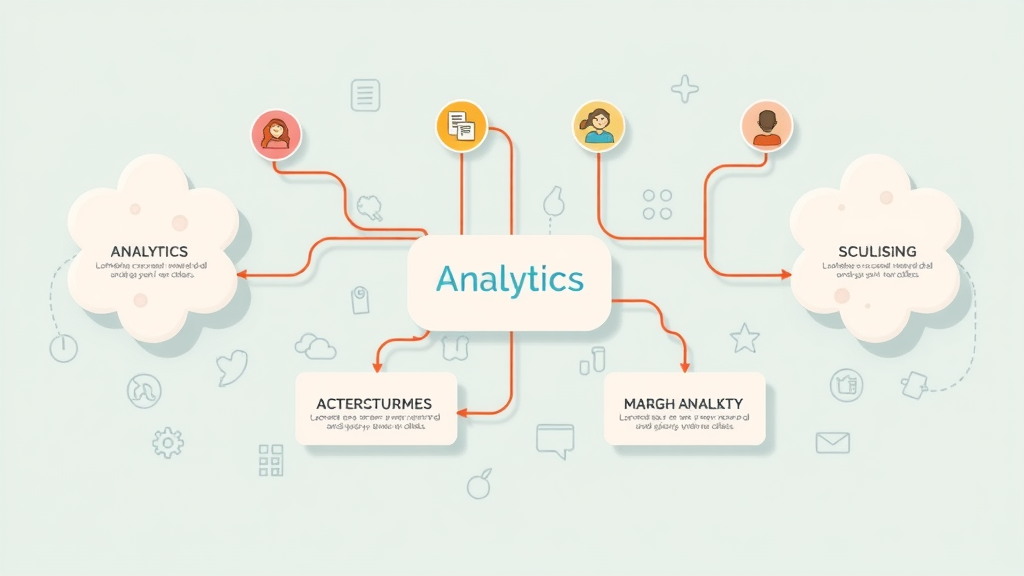Did you know that nearly 70% of businesses track social media analytics but only a fraction actually know how to turn this data into profits and growth? In a world overflowing with hashtags and trending topics, the true power of social media analytics often hides beneath the surface. Today, we’ll pull back the curtain and reveal the facts, strategies, and tools that most brands overlook—yet are critical to maximizing your digital impact.

Uncovering the Real Power of Social Media Analytics: Surprising Data and Insights
Beneath the daily flood of likes, shares, and retweets lies a treasure trove of insights that can transform ordinary marketing into a powerhouse of data-driven decisions. Yet, “Over 60% of marketers admit they still struggle to derive actionable insights from social media analytics.” What most people don’t realize is that the real value of social media analytics isn’t just in reporting numbers—it’s about unlocking deeper patterns, audience sentiment, and predictive trends. Leading brands use sophisticated analytics tools and platforms to go beyond generic metrics, tapping into the emotional heartbeat of their audience.
Businesses that harness the full potential of media analytics often outperform competitors in brand loyalty and ROI. Imagine being able to predict your next viral post, or knowing exactly which type of content resonates with your target audience. With the right media analytics tool, these insights aren’t just possible—they’re essential. Dive in as we explore the game-changing strategies and tools that most competitors haven’t yet discovered.
“Over 60% of marketers admit they still struggle to derive actionable insights from social media analytics.”
To truly unlock the potential of your analytics, it’s important to move beyond surface-level metrics and focus on actionable strategies that drive real results. If you’re looking for practical steps to turn your data into growth, explore these proven methods in Unlock Social Media Analytics for Explosive Growth—a resource packed with tactical insights for immediate impact.
What You’ll Learn About Social Media Analytics
Key terms and concepts in social media analytics
How to apply analytics tools for measurable social media results
The difference between various media analytics platforms
Advanced tips and best practices for social media analytic success
What is Social Media Analytics? (PAA)
Defining Social Media Analytics and Its Core Functions
At its core, social media analytics is the process of gathering, analyzing, and interpreting data from social media platforms to guide business decisions. This isn’t just about tracking likes and follows—a true media analytic process reveals how your audience interacts with every social media post, campaign, and channel. Social media data includes everything from engagement rates, comments, and shares, to intricate insights like sentiment analysis and user demographics. Advanced analytics tools extract actionable insights from massive volumes of media data, putting the right strategy directly in your hands.
While most companies track top-level metrics, mastering social media analytics means diving deeper—connecting patterns, diagnosing trends, and linking each data point back to your overall media strategy. Whether using free platforms or advanced media analytics tools, understanding how to decode this information is the difference between digital stagnation and accelerated growth.

How Social Media Analytics Impacts Modern Digital Strategy
The integration of social media analytics into modern digital strategy is transforming the competitive landscape. These tools provide real-time insights into what’s working—and what’s not—so marketers can fine-tune content in response to audience behavior rather than relying on guesswork. Media analytics offer more than backward-looking reports; they enable predictive modeling, allowing for agile marketing adjustments and smarter resource allocation. Leading analytics tools support cross-platform media data correlation, connecting brand voice across media channels and digital campaigns with measurable outcomes.
Today’s top brands leverage social media analytics tools to inform decisions across product launches, customer service workflows, and influencer partnerships. By understanding which type of social media post ignites engagement and when audiences are most active, organizations can personalize messaging and drive higher conversion rates. In this era of media marketing, analytics isn’t just a support system—it’s the engine behind every successful campaign.
Why Social Media Analytics Matters More than Ever
The Role of Media Analytics in Audience Engagement
Audience engagement is no longer about guesswork—it’s scientifically measured. Media analytics have changed how organizations approach every social media channel, using social media analytics tools to listen, learn, and respond to audience sentiment in real time. Social listening techniques help brands monitor conversations about their products, services, and competitors, ensuring that every response is timely and on target. This deep connection to audience preferences helps businesses shape content calendars, choose optimal posting times, and even preempt potential crises.
As digital spaces become increasingly crowded, only those who understand the “why” behind each social media data trend can adapt quickly and retain their audience. Analytics tools turn random engagement into meaningful relationships, helping teams distill thousands of comments, likes, and shares into clear feedback on what matters most to their communities.

Driving ROI with Data-Driven Social Media Strategies
A solid return on investment (ROI) from social media marketing comes down to using your media analytics wisely. By tracking and interpreting social media metrics—like click-through rates, conversion stats, and sentiment scores—businesses are able to see which initiatives actually drive sales and which simply create noise. Forward-thinking brands don’t just gather data; they act on it, constantly refining their approach to maximize results across all media platforms.
Analytics tools provide dashboards and detailed media reports that allow marketers to allocate budgets effectively, optimize ad spend, and measure real-time campaign success. Whether your brand operates on one social media platform or manages multiple media channels, data-driven analysis translates into tangible business growth, improved messaging, and increased customer satisfaction.
The Four Types of Social Media Analytics (PAA)
Descriptive, Diagnostic, Predictive, and Prescriptive Analytics Explained
Understanding the four main types of social media analytics allows businesses to gain a complete picture of their media data. With descriptive analytics, you look at basic statistics—how many people liked, shared, or commented on a social media post. Diagnostic analytics dives deeper, analyzing why a specific spike or drop in engagement occurred. Predictive analytics uses trends from your social media data to forecast audience behavior, while prescriptive analytics recommends actions to maximize your future results based on historical insights.
Each type plays a unique role in forming a holistic media strategy, and top analytics tools integrate all four, providing advanced guidance to brands. From understanding what worked in the past to planning your next big social media move, these analytic processes are the backbone of smart, successful media marketing.

Real-World Examples of Each Social Media Analytics Type
Let’s bring these four types to life:
Descriptive: Measuring the total number of shares a post received during a product launch.
Diagnostic: Identifying why engagement dropped after a policy change by examining comments, time of posting, and hashtag trends.
Predictive: Forecasting which content themes will go viral in the next quarter based on previous audience behavior patterns.
Prescriptive: Recommending best posting times for each weekday based on platform and past campaign data.
social media analytics tools
Comparison of the Four Types of Social Media Analytics |
||
Type |
Purpose |
Example |
|---|---|---|
Descriptive |
What happened? |
Number of likes, shares, and comments on a post |
Diagnostic |
Why did it happen? |
Analyzing sudden drops in engagement after a content change |
Predictive |
What could happen next? |
Projecting the impact of content themes for upcoming campaigns |
Prescriptive |
What should we do about it? |
Suggesting optimal posting times to increase engagement |
Understanding Social Media Metrics and Media Metrics
Key Social Media Metrics that Matter
Not all metrics are equal when it comes to social media analytics. Focus on key social media metrics like engagement rate, reach, impressions, click-through rate (CTR), and conversion rate. These metrics answer critical questions about how users interact with your brand and guide your ongoing media strategy decisions, ensuring every campaign supports your primary business goals rather than just boosting vanity numbers. Monitoring these metrics helps you identify which posts are truly effective and which media channels deliver the best ROI for your content.
Advanced analytics tools can automate metric tracking, consolidating data from multiple social media platforms into a unified dashboard. This overarching perspective merges detailed media reports with actionable recommendations, moving your team from data collection to meaningful analysis in record time.
Media Metrics vs. Social Media Metrics: What’s the Difference?
While the terms may seem interchangeable, media metrics and social media metrics play distinct roles in your analytics toolkit. Media metrics typically refer to broader measures of reach and influence across all digital properties—such as website visits, online ad impressions, or video views—while social media metrics dive deep into user interactions on platforms like Facebook, Instagram, or LinkedIn. Understanding the distinction is essential for a comprehensive media report, as both sets of metrics are required to accurately attribute sales, brand growth, or campaign effectiveness.
A media analytics tool often integrates these data points, helping you assess your results across every media channel and media platform. Remember, as the saying goes:
“Not all metrics are created equal—focus on those that align with your business goals.”

Popular Social Media Analytics Tools for 2024
Choosing the Best Analytics Tool for Your Business
Selecting the right social media analytics tool or media analytics tool depends on your specific needs, budget, and the platforms you use. Leading analytics tools like Sprout Social, HubSpot, and Hootsuite offer powerful dashboards, real-time data, and customizable reports. When evaluating analytics tools, prioritize ease of use, integration with existing systems (like Google Analytics), and the flexibility to adapt to shifting social media strategies. A well-chosen analytics tool becomes your marketing team’s compass—guiding tactics, budget, and even content tone for maximum impact.
Look for options that allow for seamless media data aggregation across all media channels and social media channels; this enables holistic tracking and analysis. The ideal tool should transform complex analytics into clear, actionable insights for your organization’s unique goals.

Social Media Analytics Tools for Different Media Platforms
Each social media platform and media platform offers native or third-party analytics capabilities. For example, Instagram Insights and Facebook Analytics are built for their respective platforms, while analytics tools like Sprinklr or Buffer consolidate data from multiple channels. Some tools also specialize in social listening, tracking brand sentiment and competitor performance across many platforms. Evaluate which social media analytics tool aligns with your primary media channels, whether you focus on B2C or B2B audiences, and how you plan to scale.
For enterprise brands, media analytics tools that offer automated reporting, sentiment analysis, and cross-platform media data visualization are invaluable. Small businesses may prefer streamlined tools that deliver key metrics without overwhelming complexity.
Sprout Social
Hootsuite Analytics
HubSpot Social Analytics
Google Analytics (for social traffic)
Buffer Analyze
Brandwatch
Sprinklr
Zoho Social
Socialbakers
Rival IQ
Social Media Analytics Tools Feature Matrix |
||||
Tool |
Platforms Covered |
Automated Reporting |
Sentiment Analysis |
Cross-Platform Analytics |
|---|---|---|---|---|
Sprout Social |
Facebook, Instagram, Twitter, LinkedIn |
Yes |
Yes |
Yes |
Hootsuite Analytics |
Multiple |
Yes |
No |
Yes |
HubSpot Social Analytics |
Facebook, Instagram, LinkedIn, Twitter |
Yes |
Partial |
Yes |
Google Analytics |
All via UTM |
Yes |
No |
Limited |
Buffer Analyze |
Facebook, Instagram, Twitter |
Yes |
No |
Yes |
Watch: A 2024 walkthrough comparing the Top Social Media Analytics Tools for all business sizes.
How to Read and Interpret Your Social Media Analytics Report
Step-by-Step Guide to Decoding Analytics Reports
Deciphering your social media analytics report starts with understanding what each number signifies. Begin by identifying key social media metrics: engagement (likes, shares, comments), reach (unique viewers), and conversions (desired actions). Use your analytics tool to spot trends over time, compare performance across social media channels, and flag anomalies. Don’t just record numbers—ask “why” certain spikes or dips occurred, and correlate them to campaigns, time of posting, or trending topics.
Effective media reporting involves layering these insights with qualitative data like audience sentiment or content themes. Top analytics tools let you visualize this data for easy reference, whether in graphs, tables, or charts. Regular analysis and interpretation turn data points into business decisions, helping you pivot and optimize your strategy rapidly.

From Media Data to Actionable Insights
Raw media data becomes meaningful only when converted into actionable insights. Look for patterns: Which social media posts drive the most engagement? Which platforms bring the highest conversion rates? Use breakouts by media channel to identify your strongest (and weakest) touchpoints, and tailor future content accordingly. Cross-reference your analytics reports with marketing goals to ensure that every media report supports larger business strategies.
The best brands set up feedback loops where insights from analytics tools flow directly into creative inspiration and campaign planning. This iterative process is what separates mere data collectors from digital leaders who consistently outperform the competition.
What is the 50/30/20 Rule for Social Media? (PAA)
Breaking Down the 50/30/20 Content Rule
The 50/30/20 rule offers a proven strategy for effective social media content diversification:
50% Value-driven content: Inform, educate, or entertain your audience - offers the most interaction.
30% Shared content: Reposts, collaborations, or curated third-party material - expands your network.
20% Promotional content: Direct calls to action or exclusive offers - targets conversions and sales.

How Social Media Analytics Tools Validate the 50/30/20 Rule
Monitoring your adherence to the 50/30/20 rule requires a powerful social media analytics tool that tracks the nature and impact of all content categories. Advanced analytics tools let you segment content types, evaluate engagement by format, and ensure each category proportionally supports your business goals. Detailed analytics reports surface whether value-driven and shared content are fostering deep connections, while also highlighting the ROI from promotional posts. By routinely auditing your distribution, you maintain a healthy, audience-focused feed that supports optimal media marketing outcomes.
Media analytics doesn’t just confirm your strategy—it can inspire smarter iterations, shaping your future campaigns for even better results with every quarterly review.
Tracking Multiple Social Media Channels and Platforms
Aggregating Social Media Data Across Platforms
For brands active across several social media channels, effective media analytic practices hinge on integration. Top analytics tools centralize social media data from all media platforms, simplifying multi-channel reporting so you don’t have to micromanage each feed individually. These platforms aggregate and normalize metrics, create holistic media reports, and reveal total brand health at a glance. Whether you’re comparing Twitter engagement to Instagram growth or monitoring YouTube views alongside Facebook shares, cross-platform access gives your team the information needed for unified media strategy decisions.
Look for media analytics tools that feature real-time dashboards, customizable alerts, and social listening capabilities for a comprehensive approach. Consolidated social media analytics eliminate data silos, allowing for coordinated campaigns and cohesive brand messaging.

Media Channels and Social Listening for Brand Health
Tracking varied media channels is about more than content performance—social listening tools monitor sentiment and spot early warning signs of potential PR issues. By analyzing conversations happening around your brand, competitors, or industry topics, you can respond quickly, protect your reputation, and capitalize on emerging trends. The results: healthier engagement, increased customer trust, and faster crisis resolution.
Advanced media analytics platforms combine metric tracking with keyword monitoring and emotional tone analysis. This empowered approach keeps your brand ahead, ensuring each media channel contributes positively to your digital footprint and long-term business outcomes.
Best Practices for Social Media Analytics and Media Analytics
Common Mistakes in Social Media Analytics to Avoid
Relying on surface metrics or failing to segment your social media data leads to misguided strategies and wasted resources. Common errors include tracking vanity metrics over actionable ones, neglecting cross-platform analysis, or ignoring audience feedback visible in the comments section. Focusing exclusively on quantitative results without qualitative analysis can create blind spots. To avoid these pitfalls, choose analytics tools with robust custom reporting, set clear benchmarks, and always update your media report framework to reflect changing business goals.
Don’t forget: context matters. A sudden dip in engagement may be tied to an industry trend, not a brand misstep. The best brands blend automated reporting from media analytic tools with human insight for the smartest decisions.
Regularly audit analytics reports
Track both quantitative and qualitative data
Establish clear objectives for every campaign
Customize reports to suit different internal stakeholders
Schedule frequent team check-ins to review analytics findings
Integrate cross-platform media data consistently
Respond to emerging insights with agility

“Leverage advanced analytics tools, but never discount your own interpretation and creativity.”
What is the Best Social Media Analytics Tool? (PAA)
Current Market Leaders in Social Media Analytics Tools
The best social media analytics tool is one that aligns perfectly with your goals, platforms, and scale. Leaders in 2024 include Sprout Social for comprehensive dashboarding and cross-platform support, Brandwatch for advanced AI-driven insights and social listening, and Hootsuite Analytics for robust scheduling and competitive benchmarking. HubSpot excels for marketing automation integration, while Google Analytics remains a go-to for website-linked social media tracking. Each analytics tool has its strengths, so start with a free trial and compare feature sets against your daily workflow.

How to Choose a Media Analytics Tool for Your Organization
When selecting a media analytics tool or social media analytics tools for your business, ask: What platforms will it cover? Does it offer automation? Can it perform social listening? Does it provide a user-friendly media report interface? Prioritize analytics tools that support your current media marketing needs while also preparing you to scale as your digital strategy evolves. Compare vendors for integration with CRM platforms, quality of customer support, and pricing transparency.
Above all, ensure your chosen tools convert social media data into clear, actionable insights that drive smarter decisions and sustainable digital growth.
FAQs on Social Media Analytics
Can I analyze paid and organic social media data together?
Yes, most advanced social media analytics tools and media analytics tools combine both paid and organic data, providing a comprehensive view in a single media report. This unified view is essential for accurately measuring ROI and understanding total audience impact.Which social media platforms provide native analytics?
Almost every major social media platform offers native analytics: Facebook Insights, Instagram Insights, LinkedIn Analytics, Twitter Analytics, Pinterest Analytics, and YouTube Studio—each platform provides basic metrics on engagement, audience demographics, and more.How often should I check my social media analytic reports?
Ideally, teams should check social media analytics weekly for tactical adjustments, and monthly for in-depth reviews. Real-time monitoring is important during critical campaigns or launches.What metrics best measure social media ROI?
ROI is best measured through a blend of metrics: conversion rates, sales from social traffic, cost per acquisition, engagement growth, and sentiment analysis. Choose metrics that reflect your organization’s specific goals.
Watch: Social Media Reporting Explainer - Understanding Your Analytics Dashboard
Key Takeaways: Social Media Analytics for Results
Social media analytics are essential for data-driven media marketing.
Focus on actionable social media metrics and tailor analytics tools to your brand’s needs.
Regularly audit your media analytics reports for continuous improvement.
Conclusion: Mastering Social Media Analytics for Digital Success
Smart use of social media analytics and media analytics tools is your path to digital leadership and measurable success in today’s competitive online landscape.
If you’re ready to take your social media performance to the next level, consider how engagement strategies can amplify the impact of your analytics. Understanding your data is just the beginning—actively boosting audience interaction is where true growth happens. For a deeper dive into proven engagement tactics and how to fix common pitfalls, discover the actionable advice in Struggling With Social Media Engagement? Fix It Now. This guide will help you bridge the gap between analytics and authentic connection, empowering your brand to thrive in any digital landscape.
 Add Row
Add Row  Add
Add 




Write A Comment